 W
WThe black-faced bunting is a passerine bird in the bunting family Emberizidae, a group now separated by most modern authors from the finches, Fringillidae.
 W
WThe black-headed bunting is a passerine bird in the bunting family Emberizidae. It breeds in south-east Europe east to Iran and migrates in winter mainly to India, with some individuals moving further into south-east Asia. Like others in its family, it is found in open grassland habitats where they fly in flocks in search of grains and seed. Adult males are well marked with yellow underparts, chestnut back and a black head. Adult females in breeding plumage look like duller males. In other plumages, they can be hard to separate from the closely related red-headed bunting and natural hybridization occurs between the two species in the zone of overlap of their breeding ranges in northern Iran.
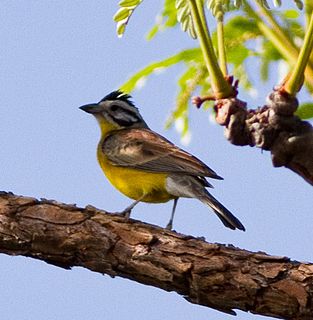 W
WThe brown-rumped bunting is a species of bird in the family Emberizidae found in Africa from Senegal to Sudan and Uganda. Its natural habitat is subtropical or tropical moist lowland forests.
 W
WThe meadow bunting or Siberian meadow bunting is a passerine bird of eastern Asia which belongs to the genus Emberiza in the bunting family Emberizidae.
 W
WThe crested bunting is a species of bird in the family Emberizidae, from the northern regions of the Indian Subcontinent stretching eastward to Southeast Asia.
 W
WThe slaty bunting is a species of bird in the family Emberizidae.
 W
WCabanis's bunting is a species of bird in the family Emberizidae.
 W
WThe Cape bunting is a passerine bird in the bunting family Emberizidae.
 W
WThe chestnut bunting is a passerine bird in the bunting family Emberizidae found in the East Palearctic.
 W
WThe chestnut-eared bunting, also called grey-headed bunting or grey-hooded bunting, with the latter name also used for grey-necked bunting, is a passerine bird in the bunting family Emberizidae.
 W
WThe cinereous bunting is a bird in the bunting family Emberizidae, a passerine family now separated by most modern authors from the finches, Fringillidae. This species was first described by Christian Ludwig Brehm.
 W
WThe cinnamon-breasted bunting or cinnamon-breasted rock-bunting, is a species of bird in the family Emberizidae.
 W
WThe cirl bunting, Emberiza cirlus, is a passerine bird in the bunting family Emberizidae, a group now separated by most modern authors from the finches, Fringillidae.
 W
WThe common reed bunting is a passerine bird in the bunting family Emberizidae, a group now separated by most modern authors from the finches, Fringillidae. The genus name Emberiza is from Old German Embritz, a bunting. The specific schoeniclus is from Ancient Greek skhoiniklos, a now unknown waterside bird.
 W
WThe corn bunting is a passerine bird in the bunting family Emberizidae, a group now separated by most modern authors from the finches, Fringillidae. This is a large bunting with heavily streaked buff-brown plumage. The sexes are similar but the male is slightly larger than the female. Its range extends from Western Europe and North Africa across to northwestern China.
 W
WCretzschmar's bunting is a passerine bird in the bunting family Emberizidae, a group now separated by most modern authors from the finches, Fringillidae.
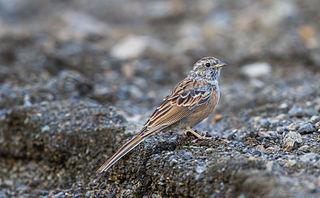 W
WGodlewski's bunting is a species of bird in the family Emberizidae. It is named after the Polish collector Victor Godlewski who obtained a specimen of which on the basis of which it was described by Taczanowski.
 W
WThe golden-breasted bunting is a passerine bird in the bunting family Emberizidae. It occurs in dry open woodlands and moist savanna in Africa south of the Sahara, but is absent from the equatorial forest belt.
 W
WGosling's bunting, also known as the grey-throated bunting, is a species of bird in the family Emberizidae. It is found in Africa from Mauritania and Senegal to south-western Sudan and north-eastern Democratic Republic of Congo. Its natural habitats are dry savannah, subtropical or tropical dry shrubland, and subtropical or tropical dry lowland grassland.
 W
WThe grey bunting is a species of bird in the family Emberizidae.
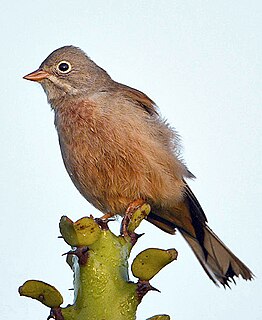 W
WThe grey-necked bunting, sometimes referred to as grey-hooded bunting is a species of bird in the family Emberizidae. It breeds along a wide distribution range from the Caspian Sea to the Altai Mountains in Central Asia and winters in parts of Southern Asia. Like other buntings it is found in small flocks.
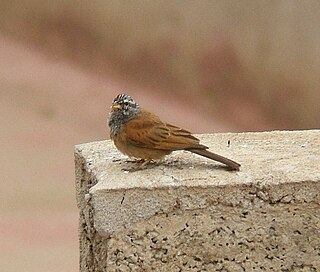 W
WThe house bunting is a passerine bird in the bunting family Emberizidae.
 W
WJankowski's bunting or rufous-backed bunting is a species of bird in the family Emberizidae.
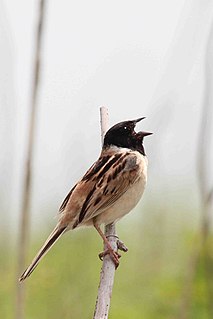 W
WThe Japanese reed bunting or ochre-rumped bunting is a bird in the family Emberizidae. The species was first described by Robert Swinhoe in 1863.
 W
WThe lark-like bunting is a species of bird in the family Emberizidae, which is native to south-western Africa.
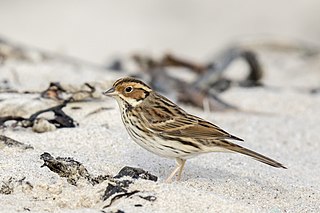 W
WThe little bunting is a passerine bird belonging to the bunting family (Emberizidae).
 W
WThe long-legged bunting is an extinct flightless species of bunting. It was distinguishable by its long legs and short wings, and it inhabited Tenerife, one of the Canary Islands. It is one of the few flightless passerines known to science, all of which are now extinct.
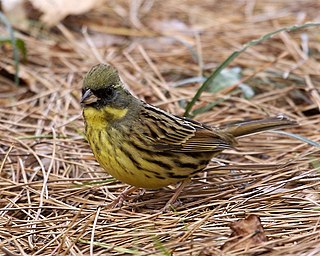 W
WThe masked bunting is a passerine bird in the bunting family Emberizidae. It is found in Sakhalin, the Kuril Islands, and Japan.
 W
WThe ortolan, also called ortolan bunting, is a Eurasian bird in the bunting family Emberizidae, a passerine family now separated by most modern scholars from the finches, Fringillidae. The genus name Emberiza is from Alemannic German Embritz, a bunting. The specific hortulana is from the Italian name for this bird, ortolana. The English ortolan is derived from Middle French hortolan, "gardener".
 W
WPallas's reed bunting, also known as Pallas's bunting, is a passerine bird in the bunting family Emberizidae, a group now separated by most modern authors from the finches, Fringillidae.
 W
WThe pine bunting is a passerine bird in the bunting family Emberizidae, a group most modern authors now separate from the finches, Fringillidae. It lives in Eurosiberia east of the Urals.
 W
WThe red-headed bunting is a passerine bird in the bunting family Emberizidae, a group now separated by most modern authors from the finches, Fringillidae.
 W
WThe rock bunting is a passerine bird in the bunting family Emberizidae, a group now separated by most modern authors from the finches, Fringillidae.
 W
WThe rustic bunting is a passerine bird in the bunting family Emberizidae, a group now separated by most modern authors from the finches, Fringillidae. The genus name Emberiza is from Old German Embritz, a bunting. The specific rustica is Latin for "rustic, simple".
 W
WThe Socotra bunting is a species of bird in the family Emberizidae.
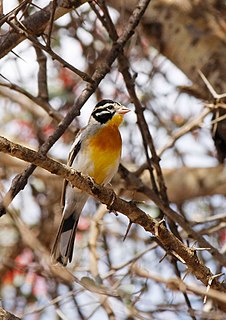 W
WThe Somali bunting or Somali golden-breasted bunting is a species of bird in the family Emberizidae.
 W
WThe striolated bunting is a passerine bird in the bunting family Emberizidae, a group now separated by most modern authors from the finches, Fringillidae.
 W
WTristram's bunting is a bird in the family Emberizidae. The species was first described by Robert Swinhoe in 1870.
 W
WVincent's bunting is a passerine bird in the bunting family Emberizidae. It was formerly considered a subspecies of the Cape bunting, and some taxonomists still consider it to be conspecific.
 W
WThe white-capped bunting or chestnut-breasted bunting is a species of bird in the family Emberizidae. It is found in Afghanistan, India, Iran, Kazakhstan, Kyrgyzstan, Nepal, Pakistan, Tajikistan, Turkmenistan, and Uzbekistan. Its natural habitats are boreal forests, boreal shrubland, and temperate grassland.
 W
WThe yellow bunting or Japanese yellow bunting is a passerine bird of eastern Asia in the bunting family Emberizidae. It is threatened by habitat loss, the use of pesticides and trapping for the cagebird industry.
 W
WThe yellow-breasted bunting is a passerine bird in the bunting family Emberizidae that is found across the Boreal and East Palearctic. The genus name Emberiza is from Old German Embritz, a bunting. The specific aureola is Latin for "golden". The bird's call is a distinctive zick, and the song is a clear tru-tru, tri-tri.
 W
WThe yellow-browed bunting is a passerine bird in the bunting family Emberizidae, a group now separated by most modern taxonomists from the finches (Fringillidae). The genus name Emberiza is from Old German Embritz, a bunting. The specific chrysophrys is from Ancient Greek khrusophrus, "golden-browed".
 W
WThe yellow-throated bunting, also known as the elegant bunting, is a species of bird in the family Emberizidae.
 W
WThe yellowhammer is a passerine bird in the bunting family that is native to Eurasia and has been introduced to New Zealand and Australia. Most European birds remain in the breeding range year-round, but the eastern subspecies is partially migratory, with much of the population wintering further south. The male yellowhammer has a bright yellow head, streaked brown back, chestnut rump, and yellow under parts. Other plumages are duller versions of the same pattern. The yellowhammer is common in open areas with some shrubs or trees, and forms small flocks in winter. Its song has a rhythm like "A little bit of bread and no cheese". The song is very similar to that of its closest relative, the pine bunting, with which it interbreeds.